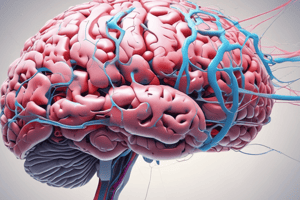Podcast
Questions and Answers
What does a marked cognitive dysfunction indicate regarding Deep Brain Stimulation (DBS) benefits in Parkinson's Disease (PD)?
What does a marked cognitive dysfunction indicate regarding Deep Brain Stimulation (DBS) benefits in Parkinson's Disease (PD)?
- It enhances the quality-of-life benefit of DBS.
- It diminishes the quality-of-life benefit of DBS. (correct)
- It improves motor function outcomes from DBS.
- It has no effect on the quality-of-life benefit of DBS.
Which symptom is likely to improve with DBS in a patient with Parkinson's Disease?
Which symptom is likely to improve with DBS in a patient with Parkinson's Disease?
- Tremor (correct)
- Postural instability
- Autonomic function
- Cognition
What symptom is unlikely to benefit from DBS according to the provided content?
What symptom is unlikely to benefit from DBS according to the provided content?
- Cognition (correct)
- Rigidity
- Motor fluctuations
- Dyskinesias
What is considered a relative contraindication to DBS in Parkinson's Disease patients?
What is considered a relative contraindication to DBS in Parkinson's Disease patients?
What effect does an increase in mobility have on a severely demented patient with PD after DBS?
What effect does an increase in mobility have on a severely demented patient with PD after DBS?
Which of the following symptoms represents a classic feature of idiopathic Parkinson's Disease that DBS does not address?
Which of the following symptoms represents a classic feature of idiopathic Parkinson's Disease that DBS does not address?
In the context of the basal ganglia-thalamocortical circuit, which state is characterized by inhibitory and excitatory projections alterations in PD?
In the context of the basal ganglia-thalamocortical circuit, which state is characterized by inhibitory and excitatory projections alterations in PD?
What is a potential negative outcome of improving motor function in a patient with severe dementia undergoing DBS?
What is a potential negative outcome of improving motor function in a patient with severe dementia undergoing DBS?
What is a major advantage of targeting the subthalamic nucleus (STN) for deep brain stimulation compared to its counterpart?
What is a major advantage of targeting the subthalamic nucleus (STN) for deep brain stimulation compared to its counterpart?
What significant factor makes STN placement contraindicated in certain patients?
What significant factor makes STN placement contraindicated in certain patients?
Which imaging technique first improved the safety and accuracy of deep brain surgery?
Which imaging technique first improved the safety and accuracy of deep brain surgery?
In what year did Benabid and colleagues demonstrate the reversible effects of high-frequency stimulation for Parkinson's symptoms?
In what year did Benabid and colleagues demonstrate the reversible effects of high-frequency stimulation for Parkinson's symptoms?
Which type of DBS target is specifically mentioned as only aiding tremor symptoms?
Which type of DBS target is specifically mentioned as only aiding tremor symptoms?
What condition is Parkinson's disease categorized as?
What condition is Parkinson's disease categorized as?
What percentage of the population is estimated to be affected by Parkinson's disease?
What percentage of the population is estimated to be affected by Parkinson's disease?
What surgical procedure was commonly performed in the early 1990s to address Parkinson’s symptoms?
What surgical procedure was commonly performed in the early 1990s to address Parkinson’s symptoms?
Who initially described the condition now known as Parkinson's disease?
Who initially described the condition now known as Parkinson's disease?
What hypothesis forms the basis for the use of deep brain stimulation (DBS) in treating motor symptoms of Parkinson's disease?
What hypothesis forms the basis for the use of deep brain stimulation (DBS) in treating motor symptoms of Parkinson's disease?
Which structure overlies the choroidal fissure and optic tract in the basal ganglia?
Which structure overlies the choroidal fissure and optic tract in the basal ganglia?
What is the role of the GPi in the basal ganglia–thalamocortical circuit?
What is the role of the GPi in the basal ganglia–thalamocortical circuit?
What specific frequency band is typically increased in Parkinson's disease, indicating abnormal neuronal synchronization?
What specific frequency band is typically increased in Parkinson's disease, indicating abnormal neuronal synchronization?
What is a key consideration in the effectiveness of DBS for Parkinson's disease?
What is a key consideration in the effectiveness of DBS for Parkinson's disease?
What anatomical area is the STN located medial to?
What anatomical area is the STN located medial to?
In which frequency range does high-frequency stimulation for DBS usually occur, especially for planning and execution of movement?
In which frequency range does high-frequency stimulation for DBS usually occur, especially for planning and execution of movement?
What is the primary technique used to achieve high spatial resolution in neuronal recordings?
What is the primary technique used to achieve high spatial resolution in neuronal recordings?
What type of electrode is typically used for recording single-unit extracellular action potentials?
What type of electrode is typically used for recording single-unit extracellular action potentials?
What potential benefit does the use of microelectrodes provide in preoperative imaging?
What potential benefit does the use of microelectrodes provide in preoperative imaging?
During microelectrode recordings, how is the position for each pass determined?
During microelectrode recordings, how is the position for each pass determined?
When entering the globus pallidus internus (GPi), what is the typical range of frequency increase observed?
When entering the globus pallidus internus (GPi), what is the typical range of frequency increase observed?
What is a noted characteristic of 'border' cells located between the GPi and GPe?
What is a noted characteristic of 'border' cells located between the GPi and GPe?
What is the consequence of the greater deformability of the DBS electrode compared to the microelectrode?
What is the consequence of the greater deformability of the DBS electrode compared to the microelectrode?
What is the typical distance from the anatomical target to begin recordings in the GPi?
What is the typical distance from the anatomical target to begin recordings in the GPi?
What is a potential postoperative concern associated with stimulator implantation?
What is a potential postoperative concern associated with stimulator implantation?
Why might unilateral implantation be considered as a surgical option?
Why might unilateral implantation be considered as a surgical option?
How do unilateral STN-DBS and GPi-DBS compare regarding cognitive performance?
How do unilateral STN-DBS and GPi-DBS compare regarding cognitive performance?
What impact does STN-DBS have on decision making under stress?
What impact does STN-DBS have on decision making under stress?
Which factor may lead to a more prudent choice for unilateral surgery in patients?
Which factor may lead to a more prudent choice for unilateral surgery in patients?
What does recent evidence suggest about the timing of bilateral implantation?
What does recent evidence suggest about the timing of bilateral implantation?
What complication may arise from the deterioration of swallowing function in patients with PD?
What complication may arise from the deterioration of swallowing function in patients with PD?
What characteristic of frame-based stereotaxy is critical to its function?
What characteristic of frame-based stereotaxy is critical to its function?
Flashcards are hidden until you start studying
Study Notes
Deep Brain Stimulation and Parkinson's Disease
- Levodopa/carbidopa therapy can cause long-term side effects, prompting interest in surgical solutions for Parkinson's Disease (PD).
- Subthalamic nucleus (STN) and globus pallidus internus (GPi) are common targets for deep brain stimulation (DBS); STN allows for greater levodopa reduction.
- Significant psychiatric illness contraindicates STN placement.
- Modern imaging techniques like CT and MRI have enhanced the safety and precision of DBS surgeries.
Historical Context
- High-frequency stimulation was first described in 1987 by Benabid, demonstrating a controllable, reversible method mimicking lesions.
- Effective pallidotomies in the 1990s revived interest in GPi lesioning for PD symptoms.
- PD affects roughly 1% of the population and is the second most common neurodegenerative disease.
Basal Ganglia Anatomy and Function
- STN is closely located to the internal capsule and substantia nigra; GPi is medial to the medial medullary lamina.
- The basal ganglia circuitry plays a pivotal role in motor control, with distinct inputs and outputs potentially targeted during DBS.
Patient Selection for DBS
- Proper patient selection involves a multidisciplinary evaluation, considering factors like cognitive function and movement disorder severity.
- Cognitive impairment impacts treatment efficacy and can increase risk after surgery.
- Improved motor function following unilateral DBS suggests it might be safer for patients with cognitive deficits.
DBS Target Selection Factors
- Studies comparing STN and GPi show no significant difference in motor symptom improvement.
- Unilateral STN-DBS on the severely affected side often results in better motor function without increasing cognitive decline compared to bilateral DBS.
Surgical Techniques in DBS
- Early DBS techniques combined anatomical targets with physiological recordings for precision.
- Frame-based stereotaxy and magnetic resonance imaging are utilized to identify targets accurately.
- Microelectrode recording (MER) provides high spatial resolution to augment preoperative imaging, confirming electrode placement during surgery.
Microelectrode Recording Procedure
- High-impedance microelectrodes are used to record action potentials, ensuring accurate trajectories and minimizing risk during electrode advancement.
- Activity patterns change notably as electrodes approach the GPi, revealing somatotopic organization relevant to targeted DBS.
Studying That Suits You
Use AI to generate personalized quizzes and flashcards to suit your learning preferences.




